
- Usage in publication:
-
- Thorold sandstone
- Thorold quartzite
- Modifications:
-
- Original reference
- Dominant lithology:
-
- Sandstone
- Quartzite
- AAPG geologic province:
-
- Appalachian basin
Summary:
Pg. 431, 460-463. [Thorold sandstone on p. 431; Thorold quartzite on p. 460.] The upper gray or Thorold sandstone [the "Gray band" of the Medina] separates the red Medina beds from overlying Clinton. Will be called Thorold quartzite, from exposure at Thorold, Ontario, on Welland Canal. Is traceable eastward to Rochester and Oswego, occurring everywhere at top of the Medina. Beyond Oswego it is represented by Oneida conglomerate. Is 10 to 12 feet thick in western New York but in Nottawassaga Township, Ontario, it is said to be 35 feet thick. Along Niagara Gorge consists of 7.5 feet of hard, massively bedded, compact quartzose sandstone resembling Whirlpool sandstone and commonly showing irregular cross-bedding; sometimes a thin basal bed is separated by a few inches of reddish shale from the main mass. Rests on Medina red sandstones and is overlain by Sodus shale (6 feet of olive-green to grayish, sometimes purplish-gray shale) [which he included in the Medina, although it had previously been included in Clinton, and is still included in that formation].
Source: US geologic names lexicon (USGS Bull. 896, p. 2142-2143).

- Usage in publication:
-
- Thorold sandstone member*
- Modifications:
-
- Overview
- AAPG geologic province:
-
- Appalachian basin
Summary:
In Niagara folio (No. 190, 1913) of the USGS, the Thorold sandstone was treated as topmost member of Albion sandstone (a name suggested by J.M. Clarke to replace "Upper Medina" of the literature), and was described as consisting of 5 feet of hard gray sandstone. In 1914 (Science, n.s., v. 39, p. 915-918), E.M. Kindle (author of Paleozoic geology of Niagara folio) objected to Albion sandstone and advocated Grabau's restricted definition of Medina (which applied the name to "Upper Medina" of the literature), and he treated Thorold sandstone as top member of Medina formation and assigned to the Clinton of Niagara Gorge the overlying shale, which he called Sodus shale.
In GSA Bull., v. 25, p. 310, 1914, C. Schuchert stated that at Thorold, Ontario, the Thorold member (consisting of 10 feet of white fine-grained sandstone) is overlain by 4 feet of bluish-green argillaceous shale, which he included in Medina formation but excluded from Thorold sandstone. In his Niagara Gorge section, however, he treated the Thorold as top member of his Medina formation and referred to the Clinton the 2.5 to 6 feet of shale disconformably overlying the Thorold and underlying the Wolcott limestone, which is "often correlated with Sodus member at Rochester" but without anything "of value to support this reference." The same year (Canada Geol. Survey Summ. Rpt., 1913, p. 179-188) M.Y. Williams treated Thorold sandstone as top division of Medina and assigned Sodus shale to the Clinton.
In 1915 (U.S. Nat. Mus. Bull., no. 92, v. 2, pl. 4) R.S. Bassler treated Thorold sandstone as top member of Albion and assigned Sodus to Clinton.
In 1918 (GSA Bull., v. 29, p. 332, 341, 359, 364, etc.) G.H. Chadwick excluded Thorold sandstone from Medina and named the shale overlying it Maplewood shale, which he showed to be considerably older than Sodus shale and, although included in Clinton group of Hall, its "stratigraphic relations are with the beds below rather than above it." In 1919 (Canada Geol. Survey Memoir 111), M.Y. Williams treated Thorold sandstone as top member of Medina-Cataract. In 1922 (Hdbk. Ind. Geol., pt. 4, Sep. Pub. 21, p. 443, 456) E.R. Cumings proposed that Albion sandstone be restricted to beds between Whirlpool sandstone and Thorold sandstone, and he included Thorold in Medina series, as did A.F. Foerste in 1923 (Denison Univ. Bull, Jour. Sci. Lab, v. 20, p. 50-51).
In 1923 (Maryland Geol. Survey Silurian vol., p. 244, 267, 347) E.O. Ulrich transferred Thorold sandstone to Clinton formation and applied Albion to underlying rocks down to base of Whirlpool sandstone.
In 1924 (Canada Dept. Mines, Geol. Survey Memoir 138) A.F. Foerste stated that Thorold sandstone is top member of Cataract formation of southern Ontario. But according to C. Schuchert, 1913 (GSA Bull., v. 24), the Cataract formation corresponds to only lower 50 feet of the 135 feet of Albion sandstone at Niagara Falls.
W. Goldring, 1931 (New York State Mus. Hdbk., no. 10, p. 317, 323), treated Thorold sandstone as basal member of Clinton and restricted Albion to underlying beds. She listed Thorold as present at Rochester and in west-central New York.
G.H. Chadwick, 1935 (AAPG Bull., v. 19, no. 5, p. 702), stated the sandstone at Rochester that was formerly called Thorold sandstone is not true Thorold, but younger and of Clinton age. He has named it Kodak white sandstone.
The USGS still [ca. 1938] classifies Thorold sandstone as top member of Albion sandstone.
Source: US geologic names lexicon (USGS Bull. 896, p. 2142-2143).
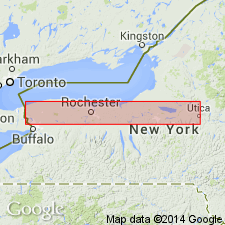
- Usage in publication:
-
- Thorold sandstone
- Modifications:
-
- Areal extent
- AAPG geologic province:
-
- Appalachian basin
Summary:
Thorold can be traced from Niagara Gorge eastward through Lockport and Gasport outcrops to Genesee Gorge and eastward from the gorge to western Cayuga Co. Overlies Grimsby sandstone; underlies (eastward) Neahga shale, Reynales limestone, Maplewood shale, and Bear Creek shale. Assigned to lower part of Clinton group.
Source: GNU records (USGS DDS-6; Reston GNULEX).
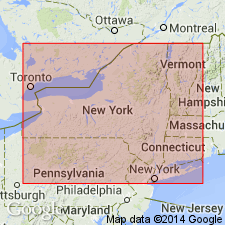
- Usage in publication:
-
- Thorold sandstone
- Modifications:
-
- Revised
- Areal extent
- AAPG geologic province:
-
- Appalachian basin
Summary:
Thorold sandstone occurs at base of Clinton group (Niagara Falls quad. Underlies Neahga shale; overlies Grimsby sandstone and shale of Medina group. Thorold of Gillette (1947) is not continuous with type Thorold. Name Kodak sandstone (Chadwick, 1920) is revived for basal sandstone of Clinton Group in NY.
Source: GNU records (USGS DDS-6; Reston GNULEX).
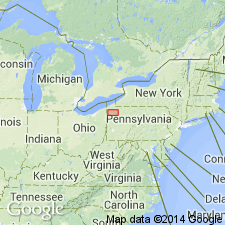
- Usage in publication:
-
- Thorold Sandstone
- Modifications:
-
- Areal extent
- AAPG geologic province:
-
- Appalachian basin
Summary:
Thorold Sandstone of Medina Group is recognized in the subsurface of Erie Co, PA. Overlies Grimsby Sandstone of Medina Group. Age is Early Silurian.
Source: GNU records (USGS DDS-6; Reston GNULEX).

- Usage in publication:
-
- Thorold Sandstone Member
- Modifications:
-
- Overview
- AAPG geologic province:
-
- Appalachian basin
Summary:
"Unconformity-bounded depositional sequences in Medina Formation cut across previously defined lithostratigraphic member boundaries. A useful new allostratigraphic-member scheme could be erected." Need for revision is greatest in upper interval containing the Thorold, Neahga, and Maplewood Members as they do not reflect natural depositional units. Cycle correlations reveal that there are actually two "Thorold" sandstones.
Source: GNU records (USGS DDS-6; Reston GNULEX).
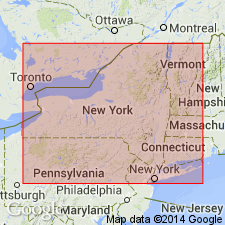
- Usage in publication:
-
- Thorold Formation
- Modifications:
-
- Revised
- AAPG geologic province:
-
- Appalachian basin
Summary:
The upper part of the Thorold Formation of the Medina Group is referred to here informally as the Cambria Member for the exposure along Lockport Junction Road on the eastern townline of Cambria, NY. Shale is capped by the Kodak Formation. New unit is described as a 2-3-m thick red and green shale with abundant leperditian ostracodes. Age is Early Silurian (Alexandrian).
Source: GNU records (USGS DDS-6; Reston GNULEX).

- Usage in publication:
-
- Thorold Formation
- Modifications:
-
- Overview
- AAPG geologic province:
-
- Appalachian basin
Summary:
The Medina Group comprises 11 facies, which can be organized into three facies associations. The previously defined color-based formations do not conform with lithic correlations except for the Whirlpool and Manitoulin. A formal major revision is being proposed by Brett and others (in press) and Duke and others (in press). The newly revised Medina Group will include the Whirlpool Sandstone at its base (virtually unchanged), the overlying Jolley Cut Formation (a tentative renaming of the Manitoulin), the Balls Falls Formation (new), the Art Park Phosphate Beds (new), the Devils Hole Formation (new), the Grimsby Formation (revised), the Power Glen Formation (revised), the Thorold Formation (revised), the Cambria Formation (new), and the Kodak Formation (resurrected). The top of the revised Grimsby is drawn at the base of the revised Thorold, which is the continuous sheet-sandstone capping cycle F. The Medina unconformably overlies Queenston Shale; unconformably underlies Clinton Group.
Source: GNU records (USGS DDS-6; Reston GNULEX).
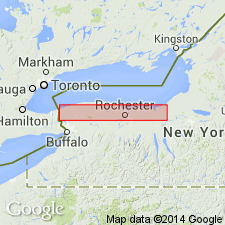
- Usage in publication:
-
- Thorold Sandstone
- Modifications:
-
- Revised
- AAPG geologic province:
-
- Appalachian basin
Summary:
Thorold Sandstone should not be included as the basal unit of the Clinton Group, as the Thorold is found below the Densmore Creek Bed (new), which marks the basal Clinton unconformity westward from Niagara Co., NY, to St. Catharines, Ontario. Eastward from Niagara Co., the units overlying the Thorold and underlying the Clinton include the 2.0- to 3.0-m-thick reddish, ostracode-bearing Cambria Shale and the 2.0- to 5.0-m-thick greenish to slightly reddish gray Kodak Sandstone. These three units are conformable with one another and therefore are included in the uppermost Medina Group.
Source: GNU records (USGS DDS-6; Reston GNULEX).
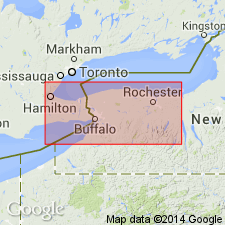
- Usage in publication:
-
- Thorold Sandstone*
- Modifications:
-
- Revised
- Redescribed
- Dominant lithology:
-
- Sandstone
- Shale
- AAPG geologic province:
-
- Appalachian basin
Summary:
Revised the Thorold Sandstone of the Medina Group in western NY by removing the upper part of the unit and creating a new formation, the Cambria Shale. The revised Thorold consists of two laterally correlative facies: (1) to the east, between Rochester and Lockport, NY, unit is mottled pink to red, cross-bedded, channel sandstone with trace fossils, (2) in Niagara region and westward, it is a light-gray to white, massive, argillaceous, pelletal sandstone. Unit is typically interbedded with thin, green, silty, shales. Thickness is 4.5 to 10.0 feet. Overlies the Grimsby Formation with a sharp but nearly conformably contact, and conformably underlies the Cambria Shale. Between Niagara Falls, NY, and Hamilton, Ont, CAN, a low-angle unconformity occurs at the top of the unit and the Neagha Shale of the Clinton overlies the Thorold. The Thorold is of Early Silurian (Llandoverian) age. [Report uses Early and Late Silurian time scale of Harland and others (1982).]
Source: GNU records (USGS DDS-6; Reston GNULEX).
For more information, please contact Nancy Stamm, Geologic Names Committee Secretary.
Asterisk (*) indicates published by U.S. Geological Survey authors.
"No current usage" (†) implies that a name has been abandoned or has fallen into disuse. Former usage and, if known, replacement name given in parentheses ( ).
Slash (/) indicates name conflicts with nomenclatural guidelines (CSN, 1933; ACSN, 1961, 1970; NACSN, 1983, 2005, 2021). May be explained within brackets ([ ]).

